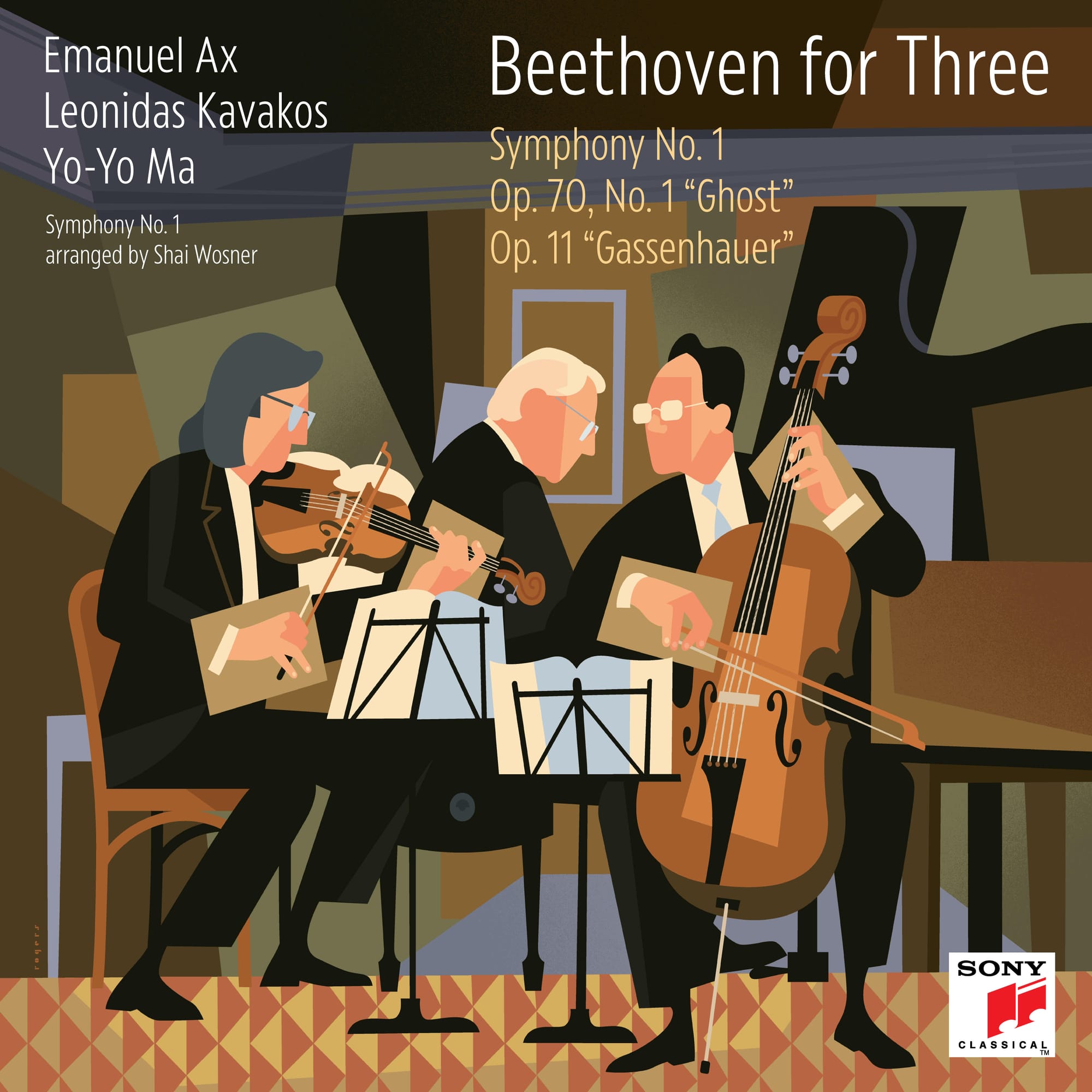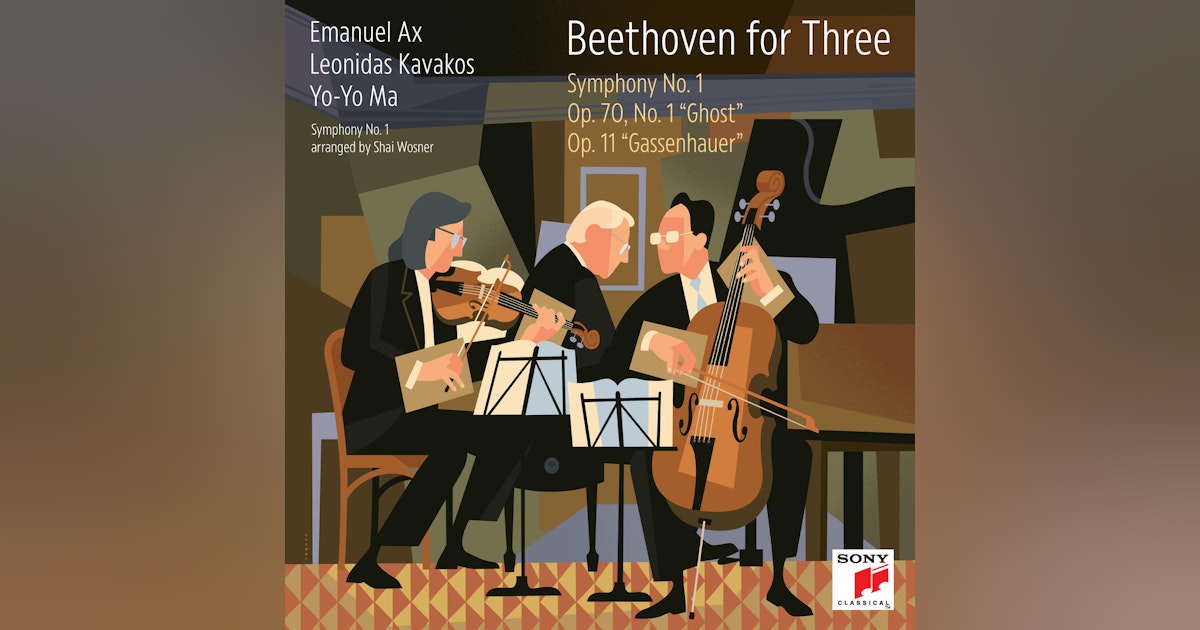Beethoven for 3, #4
there is so much to enjoy here. Chamber music lovers will snatch this up

We're back, after an unexpected break due to illness. Apologies for the disruption - initially posts may or may not be every day, but will certainly work back to the Wednesday through Sunday format shortly.
And ... there's a pile of Christmas discs quietly building up crying out for posts. Just no mince pies. Yet.
This is the fourth album in Emanuel Ax, Leonidas Kavakos, and Yo-Yo Ma's Beethoven for Three series, featuring Symphony No. 1 (Op. 21) and the ‘Gassenhauer’ (Op. 11) and ‘Ghost’ (Op. 70, No. 1) piano trios.
There is not on, but two arrangements by Shai Wosner here: the so-called “Gassenhauer” Trio is arranged for piano too (it originally included clarinet). This is completed by the “Ghost” in is original piano trio format.
Th light, chamber music proportions of Beethoven's First Symphony fit a piano trio well. The players observe the exposition repeat, and present an approach that is fresh and appealing; th ensuing Andante cantabile con moto is the perfect foil. It moves, as Beethoven's indication asks, in the manner of a suave dance. Listen to how the two complement each other, and how Ax, Kavakos and Ma are in perfect accord:
Wosner's arangement mines the vital drive of the “Menuetto” (it's really a scherzo here) , the Trio heady, Kavakos ad Ma's scales in response to the piano light and agile. I am less convinced the threadbare introduction to the final works in reduction, but there is no doubting the forward thrust of the main body:
The "Ghost" Trio is the only piece heard in its original scoring. It is the slow movement the inspired the nickname: the first is tightly constructed, an Allegro viva e con brio. Kavakos and Ma revel in Beethoven's rhythmic tossing from one istrument to the other; Ax is a wonderful chamber musician, his playing full of wonder. There is no ostentatious virtuosity; the ear is led, instead, to myriad subtleties. The music, it is clear, comes first. And how well the players deliver the dismissive first gesture (and again when we meet it again verbatim in the recapitulation). And just listen to teh magical hush round 10 minutes in:
TThe rio gets is nickname after ts slow movement (Largo assai ed espressivo); Wikipedia speculates that his “ghostly” music might have had its roots in an opera on Macbeth Beethoven was contemplating at this time; if only that came though to fruition!. Czerny, meanwhile suggested the basis was Hamlet). Anyway, its terrific music, with unique textures, threadbare and (pardon the pun) having.Ax, Ma and Kavakos kew a beautiful, entrained pianissimo that works perfectly:
The finale has an easy flow to it, beautifully rendered., and identifiably the indicated “Presto”:
I confess I grew up on the old DG recordings of Kempff, Founier and Szeryng for the Beethoven Trios, and find the pretty irreplaceable. And yet La/Ax/Kavakos provide a modern recording hat comes close. Here's the old DG:
Trio For Piano, Violin And Violoncello D Major Op. 70 No. 1 (Ghost Trio) 0:00 1st movement: Ellegro Vivace E Con Brio 7:25 2nd movement: Largo Assai Ed Espressivo 16:36 3rd movement: Presto
he final work is the so-called “Gassenhauer” Trio, Op. 11. Its original scoring is fo Pino, clarinet and cello and it is heard her in a more traditional piano trio format. I is an early wok (1797, published 1798), and is fresh and delightful as a result. It is also highly polished, its first movement requiring a fair amont of agility (Ax's finger work is particularly delicious!):
But it is the slow movement the is our chamber music magic. This is worth the price of the disc alone:
The finale is set of variations (Beethoven was an absolute master of the form from the off) on a popular Viennese street song, “Pria ch'io l'impegno" from Joseph Weigl's drama giocoso L'amor marinaro ossia Il corsaro (1797). Just allow Beethoven, channeled via Ax/Kavakos/Ma, to lead you in this exploration of a melody:
Here's Kempff and Fournier again, this time joined on clarinet by Karl Leister, so you can hear the original:
This excellent disc enjoyed digital release August 22, 2025 and on CD on August 29th, 2025 on Sony Classical.The Achilles Heel is the documentation: there is basically none, although there are pictures and recording data. Much more would have been good. That said, there is so much to enjoy here. Chamber music lovers will snatch this up.
You can purchase this disc at Amazon here. Streaming below:


